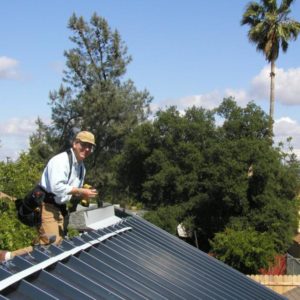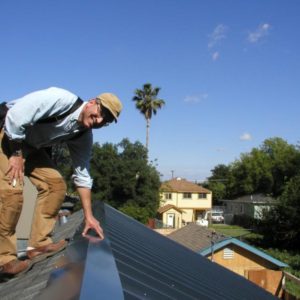Some shots of me installing a thin-film PV panel system on a standing-seam metal roof.
The thin-film panels fit between the seams, and are attached via adhesive on the panel back. The current-carrying conductors are pre-connectorized and run on the roof surface. The equipment grounding conductors are spliced with buchannan crip sleeves. The wiring is covered with a sheet metal cap.
At the top of the panel, close to the ridge, I installed a sheet metal dam in each field, to block the space under the wiring gutter (cap). This protects with wiring from rodents, and keeps the birds & rats from nesting under the cap.
It’s a net-metering system; there are no storage batteries. The power that the house doesn’t use is sold back to the utility. Power reliability is high here, no need for a back-up system, and w/o batteries, the system is cheaper, simpler, and no-maintenance. Well, minimal maintenance; the panels whould be hosed off a few times a year to clear off the dust and bird-doo.
Cliff





















Replies
In the last few months the Texas Utilities rescinded their original statute and now say it did not conform to the Federal wording.... In other words, the "Net Metering", where the meter turns both ways, is not allowed...except in an rarity where there is no other electric company... That's a BIG BACKWARD step for any wind or solar projects for Texas homeowners...
With your PV system, I heard today that the inverter used to change DC to grid AC power may be as much as 25% inefficient. Can you share what size your roof system is, actual cost, and how you get around the inverter loss?
Thanks,
Bill
We use a two meter system... one for the utility co. goesinta... the other for the pv/back to the grid goesoutta.Send in the monthly reading of the goesoutta to http://www.ncgreenpower.org/they get a payment from the utility, send it to the producer.Each pv system feeding the grid is licensed as a mini-power plant, a business, which is eligible for more than just the alternative energy tax credits/breaks. http://www.tvwsolar.com
I went down to the lobby
To make a small call out.
A pretty dancing girl was there,
And she began to shout,
"Go on back to see the gypsy.
He can move you from the rear,
Drive you from your fear,
Bring you through the mirror.
He did it in Las Vegas,
And he can do it here."
Back in 1980, I had an Enertech 1800, 110v. AC, wind generator on a 50' guyed pole. It is a synchronous motor/gearbox with a 14' wood 3-blade rotor.
The Co-op I'm on required me to have half a million dollar liability policy, which at that time, I raised my homeowner's policy at a cost of $10 a year. I also had to purchase the extra base and my "sell back" meter for around $60.
The Co-op put a strip of plastic from one of those self embossing tape machine on the inside of my sell back meter and their company meter with the word "Detense"... Their company meter and my buy-back meter turned only one direction and locked when power went backwards. Now, each meter had a new lead/wire seal, so I really had to take the Co-op's word that both meters weren't messed with and were accurately showing usage and buy back. The rates listed in my agreement papers basically said they would buy back at what amounted to 1/2 price to what it sold for....
What type of agreement did you have to agree to? What insurance and hardware amounts did it cost you other than the wiring, mounts, and panels? How much do you lose by using an inverter?
One other question, please. I've heard that the installation of PV could be "Leased" and become a tax deduction while making the payments and then bought for $1 on the last payment. Is that something of an example of extra ways to get the PV system paid for?
Thanks,
Bill
Edited 1/17/2009 10:58 am ET by BilljustBill
Edited 1/17/2009 11:16 am ET by BilljustBill
Read that NC Green Power link I posted for the current rates. I believe we pay about 8 1/2¢ a kw, and we get 13¢ for power produced.I have to find out about the insurance.Paid about $24,000 for a 2.4kw system. The dual meter trough is an off the rack item at a supply house. Don't have the receipt in front of me, maybe a couple hundred.The inverter is supposed to have around 95% efficiency.I haven't heard of the leasing program, but I will look into it.http://www.tvwsolar.com
I went down to the lobby
To make a small call out.
A pretty dancing girl was there,
And she began to shout,
"Go on back to see the gypsy.
He can move you from the rear,
Drive you from your fear,
Bring you through the mirror.
He did it in Las Vegas,
And he can do it here."
I'll jump in while we wait for CAP's reply. Curious to see what he has to say; I'm not familiar with the thin systems.
I've got a convential PV system, about 3 yrs old and 60 miles East of CAP. The inverter is a Sharp, rated at 92.4% peak conversion efficiency.
Total peak rated panel output is 3.55kW; the system is permitted at 2.9kW, taking into account the angle of my installation plus inverter and other losses. Total cost was ~$13.5K after rebates and tax refunds. The rebates & refunds thing chnages frequently - no idea where it's at now. Payback in my situation was calc'd at around 12 years including financing costs.
In CA we have bi-directional meters and several time of use rate schedules. The schedule I'm on rates are 4x higher noon to 6 pm in summer (2x in winter) than the rest of the day. Other schedules extend the range with "shoulder" hours at rates somewhere in between.
On all schedules the rates are the same no matter which way the meter is spinning (we are paid for generation at the same rate we by power - admittedly a very beneficial setup!). So, the trick is to not use a lot of juice mid-day to build the bank account.
WR, what's the square footage of your collectors?
David,
I've got 19 Kyocera KC 187 G panels. Each panel is 39" x 56" or a little over 15 sq ft. That puts the total install at around 288 sq ft.
Fortunately we had just enough space on our south-facing roof. They stair-step into a valley at the west end. Panels run long sice parallel with the ridge. Starting from the east end we have two rows of 5 panels, one row of 4, one row of 3 and one row of 2. Hope that makes sense!
Wayne
That works out to almost 12.5% efficiency for the cells, was going to say that is surprisingly high for thin film, then re-read your first post as not familiar with the brand cells you list. Do you know what max temperature your cells are speced at to produce the rated output ?
92.4% inverter is pretty good for commercial system.
Here are the thermal parameters from the spec sheet:
Nominal Operating Cell Temperature: 47* C
ISC Current temperature cooefficient: (3.18x10-3) A/*C
Voc Voltage temperature cooefficient: (-1.23x10-1) V/*C
That's ten to the negative 3 and negative 1; * is the degree sign
Hope that means something to you - means absolutely nothing to me!
Those seams lookm to be really high. Don't they shade the PV panels for a significant time - or is the sun too low anyway then that it doesn't make a difference?
Tu stultus es
Rebuilding my home in Cypress, CA
Also a CRX fanatic!
Look, just send me to my drawer. This whole talking-to-you thing is like double punishment.